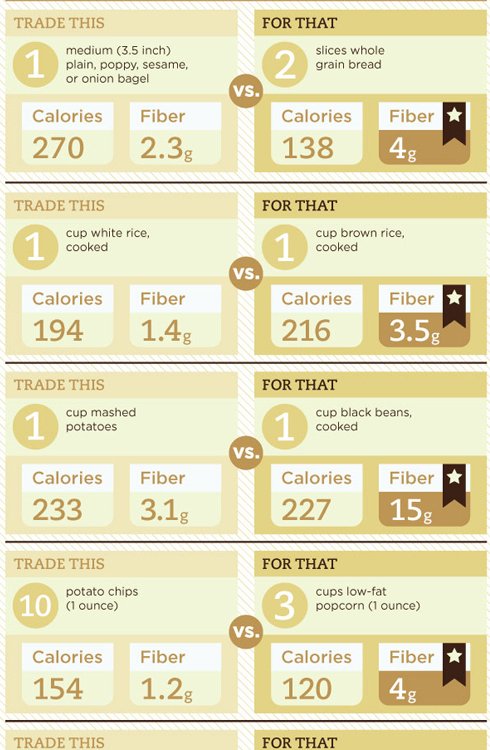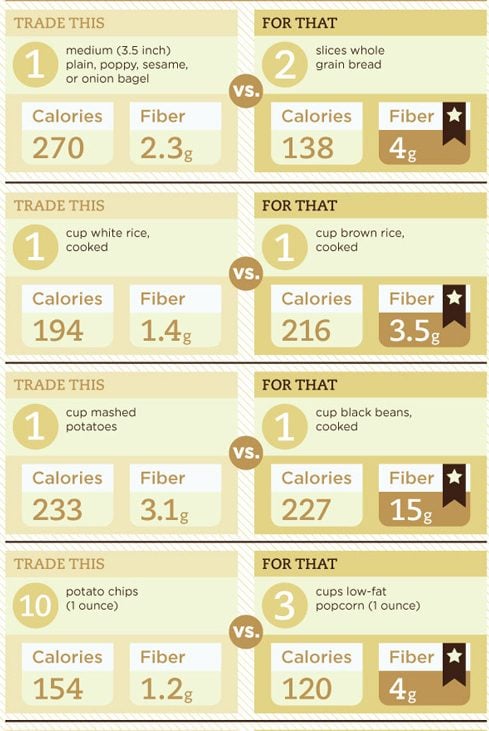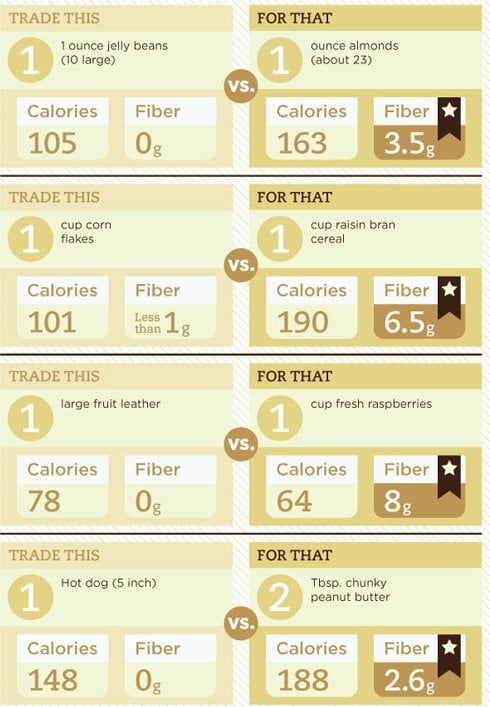Fiber is a natural substance which is found amply in fruits, veggies, and grains. It makes our digestion healthier, and adds bulk to our diet, making us feel fuller.
But an excess of fiber can lead to health problems, too. Read below what makes fiber good for our system, and what can happen when you consume too much fiber.
What are the benefits of fiber?
When you eat a diet rich in fiber, you stand to gain from the following benefits:
- Fiber feeds the good bacteria in your intestines. Since humans don’t have enzymes to digest fiber, the fiber element in the food reaches the large intestines unchanged.
When you are taking considerable amounts of soluble fiber, you are enhancing the function of friendly bacteria in the gut.
- Fiber is a colon cleanser. Doing the role of a scrub brush, it cleans out harmful bacteria and other build-ups in your intestines, thereby reducing your risk of getting colon cancer.
- Fiber slows down the rate of sugar absorption into the bloodstream. When you eat high-fiber foods, example beans or whole grains, the sugar in these foods gets absorbed slowly, which keeps your blood glucose levels from rising up.
Given the fact that fiber is an important part of the healthy balanced diet, it proves it’s ability when it comes to preventing major diseases and ailments such as diabetes, heart disease, weight gain and some cancers, while at the same time improving digestive health. Let us know the various types of fibers.
Dietary fiber is carbohydrate found in foods which are indigestible. There are two types of fiber which are classified, depending on their solubility in water.
Soluble fiber dissolves in water and is metabolized by the good bacteria in the gut
Insoluble fiber does not dissolve in water
Health authorities are of the opinion that women should eat 25 gms of fiber on a daily basis whereas 38 gm of fiber should be sufficient for men.
What are the Symptoms Of Too Much Fiber
Consciously or subconsciously, you might have taken too much of fiber than you should. These are the five symptoms that you might face, in the event of an excess of fiber intake:
- Bloating and Gas: There are certain high fiber foods which increase the levels of gas in your digestion system. Broccoli is one such high fiber veggie which causes digestive difficulties. Beans are another food item which produces gas.
- Diarrhea: When you eat an excess of fiber, you can end up with loose stools or diarrhea, if you are not careful. Loose stools are symbolic of the fact that the food you ate didn’t spend enough time in the digestive tract, and gives you a signal that you need to slow down your fiber intake.
- Constipation: Since the fiber in your food soaks up water, it can cause stools that are hard to pass. This means they spend too much time in the digestive tract.
- Dehydration: When you are not drinking sufficient water while taking excess fiber, it can speed up dehydration. In such a situation, the fiber will end up soaking the water that is available, thereby causing dehydration.
- Weight Gain: In some cases, weight gain happens, and by this, I mean in some individuals, not all. This could be due to the fiber soaking up the water in the body and retaining it from getting constipated.
However, this is a temporary phase.
In rare cases, obstruction in intestines can happen. Now let us find out what are the possible side effects of having too much of high fibre.
Too Much Fiber Side Effects
Consumption of 20 to 40 grams of fiber on a daily basis is comfortably good. But when you start to eat too much of fiber, then it can cause digestive distress.
As hinted above, following are the side effects which can happen due to overconsumption of fiber.
- Cramping: This happens when the body is not breaking down the fiber properly after you have taken an excess of it. When it happens, it can slow down the digestion, even stop it. As a result, you can experience discomfort due to intestinal cramps.
- Constipation and Diarrhoea: When you have consumed too much of fiber, it might increase the speed in which the food moves through the digestive tract, thereby causing diarrhea. It can also lead to constipation since you are giving too less a time for the body to absorb fiber.
- Poor Mineral Absorption: Our hunger at times overcomes the need to find out the fiber we are having. In such a case, we can be losing out on important minerals such as iron, magnesium, zinc, and calcium which might exit our body without getting absorbed.
And these minerals are very important for blood formation and bone health. You might then have to take a multivitamin to compensate for the lost nutrients.
The right thing to do is to learn about the best ways in which you can increase fiber in your meals.
How To Increase Fiber Intake
Here is how to include extra fiber into your daily diet with minimum effort.
1. Grains and Cereals
- Include one serving of whole grain in every meal that you take.
- Use whole wheat flour in cooking and baking, whenever possible.
- Switch over to whole grain bread. Go through the labels properly on the bread wrapping to find out the fibre each bread slice has.
- Whole wheat crackers should be kept in the bag as an easy snacking option.
- Instead of white rice, start cooking brown rice.
- Decide on cereals which should ideally have 5 grams of fiber per serving.
- Oat bran or wheat germ should be kept handy. You can happily sprinkle them over a wide range of dishes such as salad, soup, breakfast cereals and yogurt.
2. Beans and Legumes
- Make it a point to add kidney beans to your salads
- Try out international dishes that normally use whole grains and legumes either as a part of the main meal or salads.
3. Vegetables and Fruits
- Eat 5 servings of fruits and veggies on a daily basis.
- Go for fresh fruits which are high in fiber as compared to frozen or canned fruits.
- Include fresh fruit in dessert.
- Instead of drinking fruit juices, try and eat fresh fruits. This adds up to the fibre content you need.
- When you add sliced fruits in the form of bananas, peaches to your cereal, you would be introducing more of fiber to your system.
- How about grating carrots on salads? You will get the taste and fiber too.
Now that we know the kind of foods that will enhance fiber intake, how about taking a look at the ideal diet plan rich in fibre.
High Fiber Diet Plan
Indian cuisine might be full of chutneys, spices, and curries, but it has a gold mine of fibre-rich foods too.
Whole grains: When talking about a high fibre diet, you should make whole grains the rule and processed foods the exception.
Rice dishes: Rice is a favorite food on the aroma part in Indian kitchens, but instead of white rice, go for brown rice to get the fibre advantage.
Legumes: India has more than 60 types of beans and lentils. And ‘dal’ refers to a split legume. Some of the best fibre-rich legumes include split peas, chickpeas, mung beans and lentils. Did you know that 1 cup of cooked chickpeas has 12.5 gms of fiber?
Vegetables: There are abundant varieties of fiber-rich vegetables in the Indian culinary basket. Examples include spinach, cauliflower, peas, potatoes, pumpkin and sweet potatoes are key ingredients in many of our dishes.
Fruits: There is never a fruit (and fiber-rich too) which you won’t find in the Indian soil. There are mangoes, coconuts, and oranges which you can eat in raw form or include them in your dishes.
Here is a sample menu which will give you about 37 grams of fiber.
Now that you have read about the fiber on such a macro level, you need to assess how much of fiber you are taking each day – is it under or over the prescribed limit.
Consult your dietician or nutritionist on fiber-rich meal plans. This will help you achieve your fiber target goals in an optimum way. I hope I was able to widen your perspective about fiber – an often missed out necessary component in our diet.




